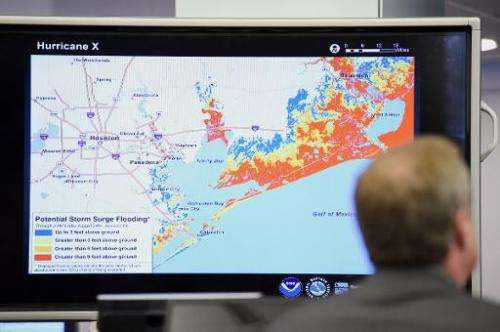A graphic presented by the National Oceanic and Atmospheric Administration (NOAA) of potential storm surge flooding in the Gulf Coast region as NOAA issued the initial outlook for the 2014 Atlantic hurricane season on May 22, 2014 in New York
Despite the quiet forecast for this year's hurricane season, the director of the Miami-based National Hurricane Center warned Thursday not to let guards down completely.
Rick Knabb, director of the National Oceanic and Atmospheric Administration's NHC, emphasized that even a single storm that hits land can have a huge impact.
He cautioned residents of all hurricane-prone areas, from the Caribbean to the United States, to be prepared, "because the consequences of not preparing are way too high."
Forecasters last week predicted the 2014 Atlantic hurricane season will be "near or below average," thanks to an expected El Nino phenomenon, with between eight and 13 tropical storms originating in the Atlantic Ocean, of which three to six could rise to hurricane strength.
But, "regardless of what the season forecast says, regardless of what 'El Nino' might do, regardless of how many years it has been since you've been impacted, you've got to prepare the same every year," Knabb said.
He stressed that seasonal forecasts—which cover the period from June 1 to November 30—are not an exact science.
"Last year clearly showed that," Knabb said, referring to predictions of a more active than usual 2013 hurricane season, which ended up being the calmest on record since 1982.
"But even if we could issue a perfect seasonal forecast in terms of the overall number of hurricanes and storms, that still wouldn't tell you where the storms and hurricanes are going to go," he said.
Last week, the first named storm of the season became a category-four hurricane in the Pacific Ocean.
Although it remained far away from land, the storm sparked rains that have led to three deaths in Mexico. It has since been downgraded to a tropical depression.
© 2014 AFP





















